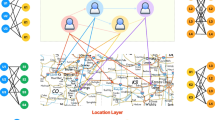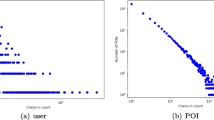Abstract
In location-based social network platforms, the point-of-interest(POI) recommendation is an essential function to serve users. The existing POI recommendation algorithms are rarely able to fully integrate various factors affecting the POI recommendation and cannot make dynamic recommendations to users over time. To address this issue, POI recommendation based on a multiple bipartite graph network model (MBR) is proposed. To reduce the overall complexity of the recommendation algorithm, we propose a clustering algorithm based on graph model, which determines the center of user clustering in the established user graph. An algorithm for finding the sparsest subgraph is built to cluster users who have social friendships or check in at similar POI, which significantly excludes more dissimilar users and makes the final recommendation more effective, as well as reducing the algorithm’s complexity. To make more accurate recommendations to users, a large heterogeneous network of six weighted bipartite graphs is built based on the user clustering to describe the relations between users’ social relationships, geographical locations of POI, and temporal information. The original Large-scale Information Network Embedding (LINE) model is too complex to be adopted for the learning of vertex embedding, thus it is optimized by negative sampling and Alias sampling methods and are fused with bipartite graphs, which accelerates the training speed. Finally, simulation experiments are conducted with the Gowalla dataset to verify the MBR algorithm, and the results show that the algorithm outperforms another three recommendation algorithms in terms of time awareness.









Similar content being viewed by others
References
Ma C, Yan Z, Chen CW (2019) SSPA-LBS: scalable and social-friendly privacy-aware location-based services. IEEE Trans Multimed 21:2146–2156. https://doi.org/10.1109/TMM.2019.2892300
Yin H, Wang W, Wang H et al (2017) Spatial-aware hierarchical collaborative deep learning for POI recommendation. IEEE Trans Knowl Data Eng 29:2537–2551. https://doi.org/10.1109/TKDE.2017.2741484
Ruihong Z, Zhihua H (2020) Collaborative filtering recommendation algorithm based on Bee Colony K-means clustering model. Microprocess Microsyst 2:103424. https://doi.org/10.1016/j.micpro.2020.103424
Song B, Gao Y, Li X-M (2020) Research on collaborative filtering recommendation algorithm based on mahout and user model. J Phys Conf Ser 1:12095
Yu X, Peng Q, Xu L et al (2021) A selective ensemble learning based two-sided cross-domain collaborative filtering algorithm. Inf Process Manag. https://doi.org/10.1016/j.ipm.2021.102691
Teimoorinia H, Shishehchi S, Tazwar A et al (2021) An astronomical image content-based recommendation system using combined deep learning models in a fully unsupervised mode. Astron J 161:227. https://doi.org/10.3847/1538-3881/abea7e
Patra BG, Roberts K, Wu H (2020) A content-based dataset recommendation system for researchers-a case study on Gene Expression Omnibus (GEO) repository. Database 2020:103399. https://doi.org/10.1093/database/baaa064
Khelloufi A, Ning H, Dhelim S et al (2021) A social-relationships-based service recommendation system for SIoT devices. IEEE Internet Things J 8:1859–1870. https://doi.org/10.1109/JIOT.2020.3016659
Bin S, Sun G (2021) Matrix factorization recommendation algorithm based on multiple social relationships. Math Probl Eng 2021:1–8. https://doi.org/10.1155/2021/6610645
Li X, Ma D, Ren Y et al (2021) Large-scale prediction of drug-protein interactions based on network information. Curr Comput Aided Drug Des. https://doi.org/10.2174/1573409917666210315094213
Qi ZX, Wang HZ, Wang AJ (2021) Impacts of dirty data on classification and clustering models: an experimental evaluation. J Comput Sci Technol 36:806–821. https://doi.org/10.1007/s11390-021-1344-6
Liu Y, Lyu C, Liu Z, Cao J (2021) Exploring a large-scale multi-modal transportation recommendation system. Transp Res Part C Emerg Technol 126:103070. https://doi.org/10.1016/j.trc.2021.103070
Jiang S, Qian X, Shen J et al (2015) Author topic model-based collaborative filtering for personalized POI recommendations. IEEE Trans Multimed 17:907–918. https://doi.org/10.1109/TMM.2015.2417506
Ye M, Yin P, Lee W-C, Lee D-L (2011) Exploiting geographical influence for collaborative point-of-interest recommendation. In: Proceedings of the 34th international ACM SIGIR conference on Research and development in Information Retrieval. pp 325–334. https://doi.org/10.1145/2009916.2009962
Herlocker J, Konstan JA, Riedl J (2002) An empirical analysis of design choices in neighborhood-based collaborative filtering algorithms. Inf Retr Boston 5:287–310. https://doi.org/10.1023/A:1020443909834
Linden G, Smith B, York J (2003) Amazon. com recommendations: item-to-item collaborative filtering. IEEE Internet Comput 7:76–80. https://doi.org/10.1109/MIC.2003.1167344
Meng F, Gao D, Li W, et al (2013) A unified graph model for personalized query-oriented reference paper recommendation. In: Proceedings of the 22nd ACM international conference on Information & Knowledge Management. pp 1509–1512. https://doi.org/10.1145/2505515.2507831
Gao H, Tang J, Hu X, Liu H (2015) Content-aware point of interest recommendation on location-based social networks. In: Twenty-ninth AAAI Conference on Artificial Intelligence
Song X, Guo Y, Chang Y et al (2020) A hybrid recommendation system for marine science observation data based on content and literature filtering. Sensors (Switzerland) 20:1–17. https://doi.org/10.3390/s20226414
Kumbhare TA, Chobe SV (2014) An overview of association rule mining algorithms. Int J Comput Sci Inf Technol 5:927–930
Yang QX, Sun H (2018) Apriori algorithm based on weight vector matrix reduction. Comput Eng Des 39:692–693
Agrawal R, Swami A, Imielinski T (1993) Database mining: a performance perspective. IEEE Trans Knowl Data Eng 5:914–925. https://doi.org/10.1109/69.250074
Wang W, Yin H, Sadiq S, et al (2016) SPORE: a sequential personalized spatial item recommender system. In: 2016 IEEE 32nd International Conference on Data Engineering (ICDE). pp 954–965. https://doi.org/10.1109/ICDE.2016.7498304
Li H, Ge Y, Hong R, Zhu H (2016) Point-of-interest recommendations: learning potential check-ins from friends. In: Proceedings of the 22nd ACM SIGKDD international conference on knowledge discovery and data mining. pp 975–984. https://doi.org/10.1145/2939672.2939767
Liu B, Qian T, Liu B et al. (2017) Learning spatiotemporal-aware representation for POI recommendation. arXiv Prepr https://arxiv.org/abs/1704.08853
Zhang J-D, Chow C-Y, Li Y (2014) Lore: Exploiting sequential influence for location recommendations. In: Proceedings of the 22nd ACM SIGSPATIAL International Conference on Advances in Geographic Information Systems. pp 103–112. https://doi.org/10.1145/2666310.2666400
Mikolov T, Chen K, Corrado G, Rey DJ (2013) Distributed representations of words and phrases and their compositionality. Nips 2:1–9
Zhao S, Lyu MR, King I (2018) Geo-teaser: Geo-temporal sequential embedding rank for POI recommendation. In: SpringerBriefs in Computer Science. pp 57–78.https://doi.org/10.1007/978-981-13-1349-3_4
Zhou T, Ren J, Medo M, Zhang YC (2007) Bipartite network projection and personal recommendation. Phys Rev E Stat Nonlinear Soft Matter Phys 76:46115. https://doi.org/10.1103/PhysRevE.76.046115
Zhang X-M, Jiang S (2012) Personalized recommendation algorithm based on weighted bipartite network. J Comput Appl 32:654–657
Liu K, Shi X, Kumar A, et al (2016) Temporal learning and sequence modeling for a job recommender system. In: Proceedings of the Recommender Systems Challenge. pp 1–4. https://doi.org/10.1145/2987538.2987540
Zhou Y, Wen D, Yuan F et al (2012) Research of online water quality monitoring system based on Zigbee network. Adv Inf Sci Serv Sci 4:255–261. https://doi.org/10.4156/AISS.vol4.issue5.30
Xie M, Yin H, Wang H, et al (2016) Learning graph-based poi embedding for location-based recommendation. In: Proceedings of the 25th ACM International on Conference on Information and Knowledge Management. pp 15–24. https://doi.org/10.1145/2983323.2983711
Zhao F, Zhang Y, Lu J (2021) ShortWalk: an approach to network embedding on directed graphs. Soc Netw Anal Min 11:1–12. https://doi.org/10.1007/s13278-020-00714-y
Zhang G, Chen J (2021) Non-negative matrix factorization via adaptive sparse graph regularization. Multimed Tools Appl 80:12507–12524. https://doi.org/10.1007/s11042-020-10247-3
Yao J, Wang H, Fu G, Wang L (2020) Hyperspectral image unmixing method based on multiple Kernel graph non-negative matrix factorization. J. Phys. Conf. Ser. 2:1389
Tang J, Qu M, Wang M, et al (2015) Line: Large-scale information network embedding. In: Proceedings of the 24th International Conference on World Wide Eeb. pp 1067–1077 https://doi.org/10.1145/2736277.2741093
Li Z, Wu S, Cui Z, Zhang X (2021) GraphFM: Graph Factorization Machines for Feature Interaction Modeling. arXiv Prepr https://arxiv.org/abs/2105.11866
Wang F, Wang X, Wang X et al (2021) DEMLP: DeepWalk embedding in MLP for miRNA-disease association prediction. J Sens 2021:1–8. https://doi.org/10.1155/2021/9678747
Spitzer F (2013) Principles of random walk. Springer, Berlin
Tong H, Faloutsos C, Pan JY (2006) Fast random walk with restart and its applications. In: Proceedings-IEEE International Conference on Data Mining, ICDM. pp 613–622. https://doi.org/10.1109/ICDM.2006.70
Tay DBH, Lin Z (2015) Design of near orthogonal graph filter banks. IEEE Signal Process Lett 22:701–704. https://doi.org/10.1109/LSP.2014.2368128
Gharibshah J, Jalili M (2014) Connectedness of users-items networks and recommender systems. Appl Math Comput 243:578–584. https://doi.org/10.1016/j.amc.2014.06.024
Zhang JD, Chow CY, Li Y (2015) IGeoRec: a personalized and efficient geographical location recommendation framework. IEEE Trans Serv Comput 8:701–714. https://doi.org/10.1109/TSC.2014.2328341
Ning H, Dhelim S, Aung N (2019) PersoNet: friend recommendation system based on big-five personality traits and hybrid filtering. IEEE Trans Comput Soc Syst 6:394–402. https://doi.org/10.1109/TCSS.2019.2903857
Zhang Y, Liu G, Liu A et al (2020) Personalized geographical influence modeling for POI recommendation. IEEE Intell Syst 35:18–27. https://doi.org/10.1109/MIS.2020.2998040
Duan R, Jiang C, Jain HK et al (2019) Integrating geographical and temporal influences into location recommendation: a method based on check-ins. Inf Technol Manag 20:73–90. https://doi.org/10.1007/s10799-018-0293-4
Mikolov T, Chen K, Corrado G, Dean J (2013) Efficient estimation of word representations in vector space. arXiv Prepr https://arxiv.org/abs/1301.3781
Singh SK, Dwivedi DRK (2020) Data mining: dirty data and data cleaning. SSRN Electron J. https://doi.org/10.2139/ssrn.3610772
Moradi P, Ahmadian S, Akhlaghian F (2015) An effective trust-based recommendation method using a novel graph clustering algorithm. Phys A Stat Mech Appl 436:462–481. https://doi.org/10.1016/j.physa.2015.05.008
Zhou T, Chen L, Shen J (2017) Movie Recommendation System Employing the User-Based CF in Cloud Computing. In: Proceedings-2017 IEEE International Conference on Computational Science and Engineering and IEEE/IFIP International Conference on Embedded and Ubiquitous Computing, CSE and EUC 2017. pp 46–50. https://doi.org/10.1109/CSE-EUC.2017.194
Ozsoy MG, Polat F, Alhajj R (2016) Time preference aware dynamic recommendation enhanced with location, social network and temporal information. In: 2016 IEEE/ACM International Conference on Advances in Social Networks Analysis and Mining (ASONAM). pp 909–916. https://doi.org/10.1109/ASONAM.2016.7752347
Yuan Q, Cong G, Ma Z, et al (2013) Time-aware point-of-interest recommendation. In: Proceedings of the 36th International ACM SIGIR Conference on Research and Development in Information Retrieval. pp 363–372. https://doi.org/10.1145/2484028.2484030
Ahmed A, Shervashidze N, Narayanamurthy S, et al (2013) Distributed large-scale natural graph factorization. In: WWW 2013-Proceedings of the 22nd International Conference on World Wide Web. pp 37–47. https://doi.org/10.1145/2488388.2488393
Perozzi B, Al-Rfou R, Skiena S (2014) DeepWalk: Online learning of social representations. In: Proceedings of the ACM SIGKDD International Conference on Knowledge Discovery and Data Mining. pp 701–710. https://doi.org/10.1145/2623330.2623732
Acknowledgements
This work was supported in part by the Key Project Foundation of Tianjin under Grant 15ZXHLGX003901, Tianjin Natural Science Foundation under Grant 19JCYBJC15800 and National Natural Science Foundation of China under Grant 61802281 and 61702366.
Author information
Authors and Affiliations
Corresponding author
Additional information
Publisher's Note
Springer Nature remains neutral with regard to jurisdictional claims in published maps and institutional affiliations.
Rights and permissions
About this article
Cite this article
Lang, C., Wang, Z., He, K. et al. POI recommendation based on a multiple bipartite graph network model. J Supercomput 78, 9782–9816 (2022). https://doi.org/10.1007/s11227-021-04279-1
Accepted:
Published:
Issue Date:
DOI: https://doi.org/10.1007/s11227-021-04279-1




